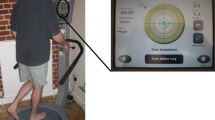Abstract
Impaired proprioceptive perception and the balance function are known to associate with knee osteoarthritis. The previous publications have reported the beneficial effects of proprioceptive exercises on mild or moderate knee osteoarthritis. Scientific data in the literature regarding their effects in advanced stages of knee osteoarthritis are lacking. The objective of this study is to investigate the impact of the proprioceptive exercises on balance, proprioceptive perception and clinical findings in advanced-stage knee osteoarthritis. Fifty-four patients diagnosed as having knee osteoarthritis according to the American Collage of Rheumatology criteria with grade of 3 or higher according to the Kellgren–Lawrence scale were enrolled in the study. Patients were allocated randomly into two groups. The study group included 30 patients, and the control group included 24 patients. The proprioceptive perception was assessed by the ability to reproduce the knee position. The balance function was assessed by stabilometric evaluation in static and dynamic patterns. The clinical evaluation was made by using Western Ontario and McMaster Universities Osteoarthritis Index (WOMAC). Patients were reevaluated after the three-week proprioceptive rehabilitation program. The improvement in the scores of static balance was significant statistically. No significant improvement in the dynamic balance scores was obtained. Although the measurements of proprioceptive perception showed a tendency toward improvement, the difference was not significant statistically. The WOMAC scores showed better improvements in the study group. As conclusion, in further stages of knee osteoarthritis, proprioceptive exercises have beneficial effects on static balance and to some extent on proprioceptive accuracy. In the treatment for advanced knee osteoarthritis, adding exercises specifically targeting the proprioceptive and balance dysfunction might be useful.
Similar content being viewed by others
References
Knoop J, Steultjens MPM, van der Leeden M, van der Esch M, Thorstensson CA, Roorda LD, Lems WF, Dekker J (2011) Proprioception in knee osteoarthritis: a narrative review. Osteoarthr cartil 19:381–388
Hassan BS, Mocket S, Doherty M (2001) Statik postural sway, proprioception and maximal voluntary quadriceps contraction in patients with knee osteoarthritis and normal control subjects. Ann Rheum Dis 60:612–618
Hurley MV (1999) The role of muscle weakness in the pathogenesis of osteoarthritis. Rheum Dis Clin North Am 25(2):283–297
Diracoglu D, Aydın R, Baskent A, Celik A (2005) Effects of kinesthesia and balance exercises in knee osteoarthritis. J Clin Rheumatol 11(6):303–310
Sharma L (1999) Proprioceptive impairment in knee osteoarthritis. Rheum Dis Clin North Am 25:299–314
Pai YC, Rymer WZ, Chang RW, Sharma L (1997) Effect of age and osteoarthritis on knee proprioception. Arthritis Rheum 40(12):2260–2265
Turcot K, Hagemeister N, de Guise JA, Aissaoui R (2011) Evaluation of unipodal stance in knee osteoarthritis patients using knee accelerations and center of pressure. Osteoarthr Cartil 19:281–286
Collins AT, Blackburn JT, Olcott CW, Miles J, Jordan J, Dirschl DR, Weinhold PS (2010) Stochastic resonance electrical stimulation to improve proprioception in knee osteoarthritis. Knee. doi:10.1016/j.knee.2010.07.001
Trans T, Aaboe J, Henriksen M, Christensen R, Bliddal H, Lund H (2009) Effect of whole body vibration exercise on muscle strength and proprioception in females with knee osteoarthritis. Knee 16:256–261
Salo P (1999) The role of joint innervation in the pathogenesis of arthritis. Can J Surg 42:91–100
Hansen MS, Dieckmann B, Jensen K, Jakobsen BW (2000) The reliability of balance tests performed on the kinesthetic ability trainer (KAT 2000). Knee Surg Sports Traumatol Arthrosc 8:180–185
Jadelis K, Miller M, Ettinger WH, Messier SP (2001) Strength, balance and the modifying effects of obesity and knee pain: results from the observational arthritis study in seniors (OASIS). J Am Geriart Soc 49(7):884–891
Messier SP, Glasser JL, Ettinger WH (2002) Declines in strength and balance in older adults with chronic knee pain: a 30 month longitudinal observational study. Arthritis Rheum 47(2):141–148
Ledin T, Kronhed AC, Moller C, Moller M, Odkvist LM, Olsson B (1991) Effects of balance training in elderly evaluated by clinical tests and dynamic posturography. J Vestib Res 1:129–138
Messier SP, Royer TD, Crave TE, O’Toole ML, Burns R, Ettinger WH Jr (2000) Long term exercise and its effect on balance in older osteoarthritic adults: results from the fitness, arthritis and seniors trial (FAST). J Am Geriatr Soc 48:131–138
Soumi R, Koceja DM (2000) Postural sway characteristics in woman with lower extremity arthritis before and after an aquatic exercise intervention. Arch Phys Med Rehabil 81:780–785
Hain TC, Fuller L, Weil L, Kotsias J (1999) Effects of T’ai Chi on balance. Arch Otolaryngol Head Neck Surg 125:1191–1195
Lichtenstein MJ, Shields SL, Shivai RG, Burger C (1989) Exercise and balance in aged woman: a pilot controlled clinical trial. Arch Phys Med Rehabil 70:138–143
Lord SR, Castell S (1994) Physical activity program for older persons: effect on balance, strength, neuromuscular control and reaction time. Arch Phys Med Rehabil 75:648–652
Barrett DS, Cobb AG, Bentley G (1991) Joint proprioception in normal, osteoarthritic and replaced knees. J Bone Joint Surg Br 73(1):53–56
Hurley MV, Scott DL, Rees J, Newham DJ (1997) Sensorimotor changes and functional performance in patients with knee osteoarthritis. Ann Rheum Dis 56(11):641–648
O’Reilly S, Jones A, Muri KR, Doherty M (1998) Quadriceps weakness in knee osteoarthritis: the effect on pain and disability. Ann Rheum Dis 57(10):588–594
Wegener L, Kissner C, Nichols D (1997) Static and dynamic balance responses in persons with bilateral knee osteoarthritis. J Orthop Sports Phys Ther 25(1):13–18
Johansson H, Sjolander P, Sojka P (1991) Receptors in the knee joint ligaments and their role in the biomechanics of the joint. Crit Rev Biomed Eng 18(5):341–368
Gustafson AS, Lisbert N (2000) Changes in balance performance in physically active elderly people aged 73–80. Scand J Rehabil Med 32:168–172
Author information
Authors and Affiliations
Corresponding author
Rights and permissions
About this article
Cite this article
Duman, I., Taskaynatan, M.A., Mohur, H. et al. Assessment of the impact of proprioceptive exercises on balance and proprioception in patients with advanced knee osteoarthritis. Rheumatol Int 32, 3793–3798 (2012). https://doi.org/10.1007/s00296-011-2272-5
Received:
Accepted:
Published:
Issue Date:
DOI: https://doi.org/10.1007/s00296-011-2272-5




